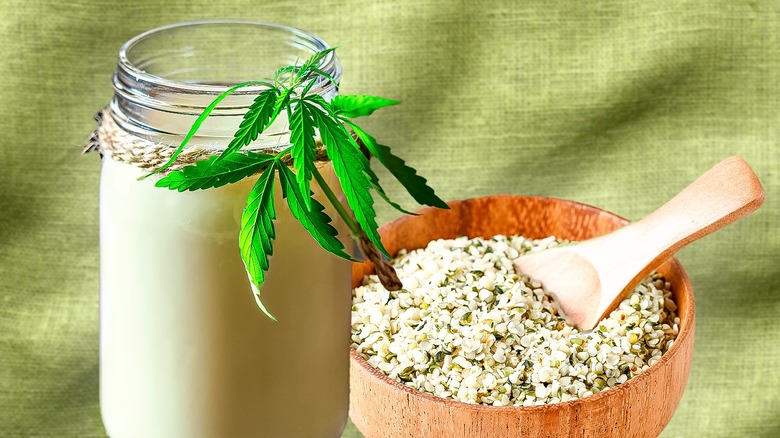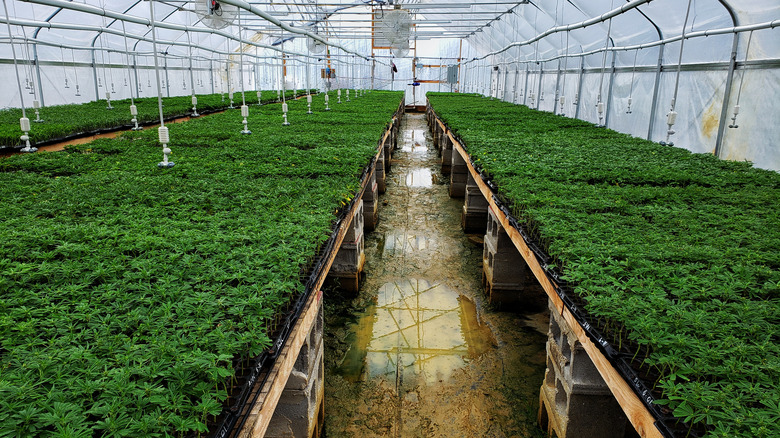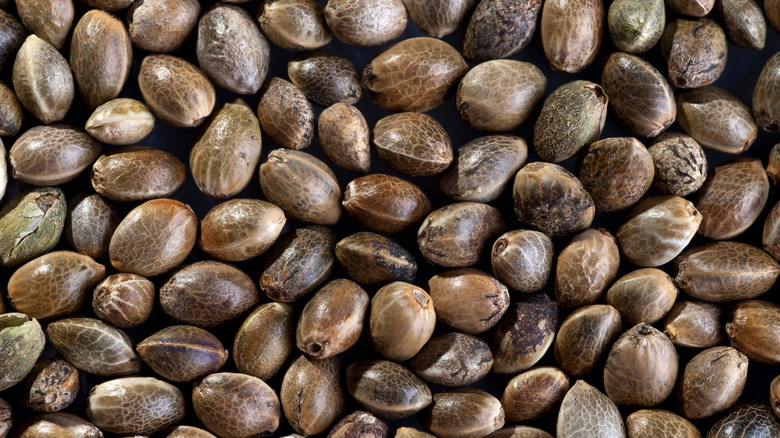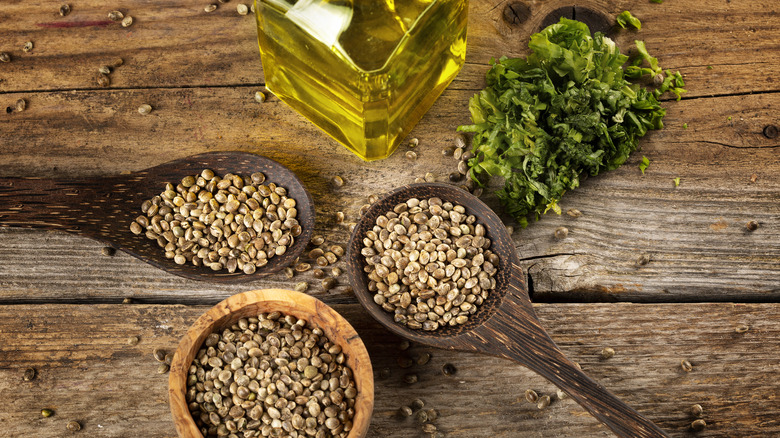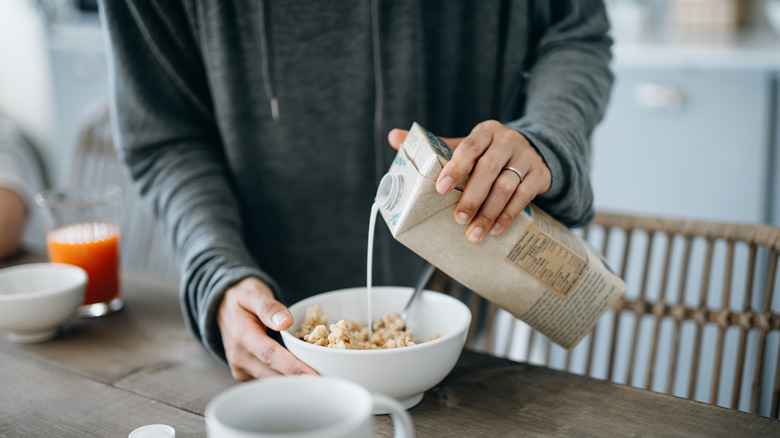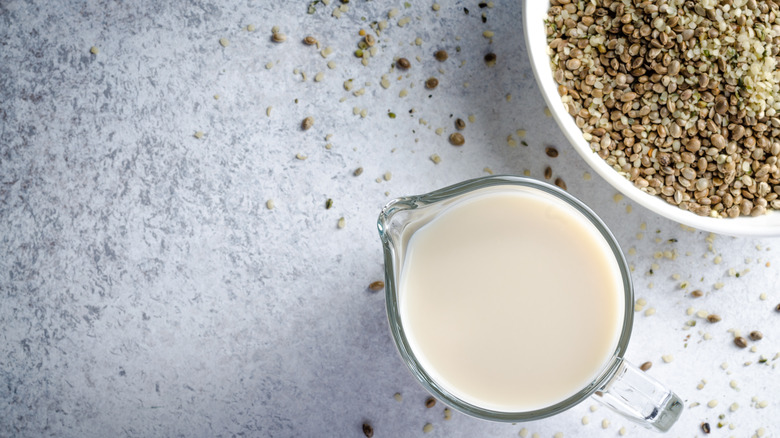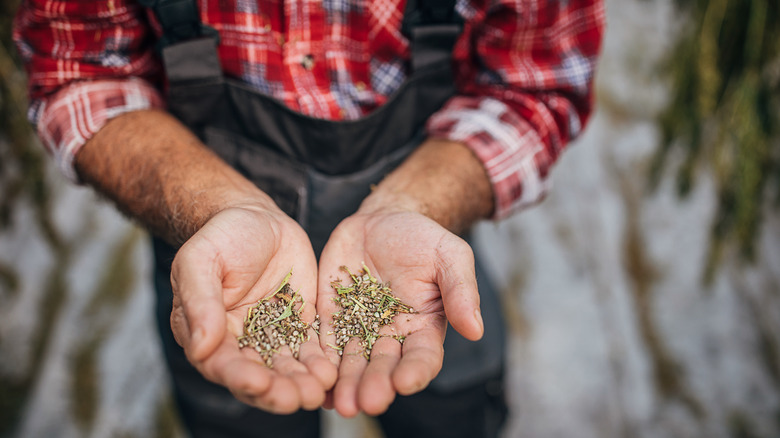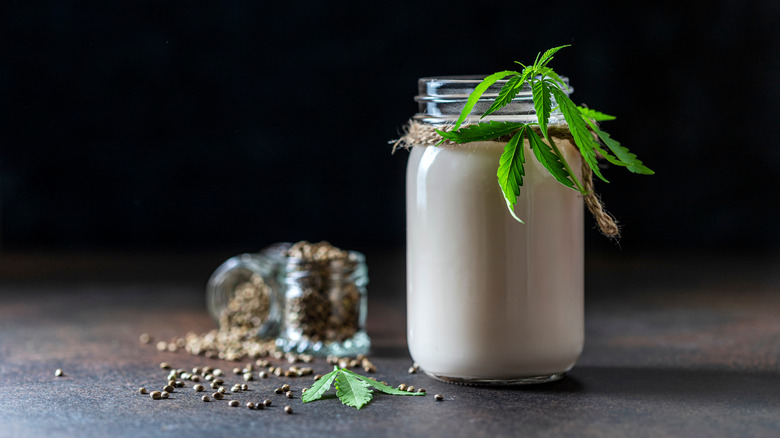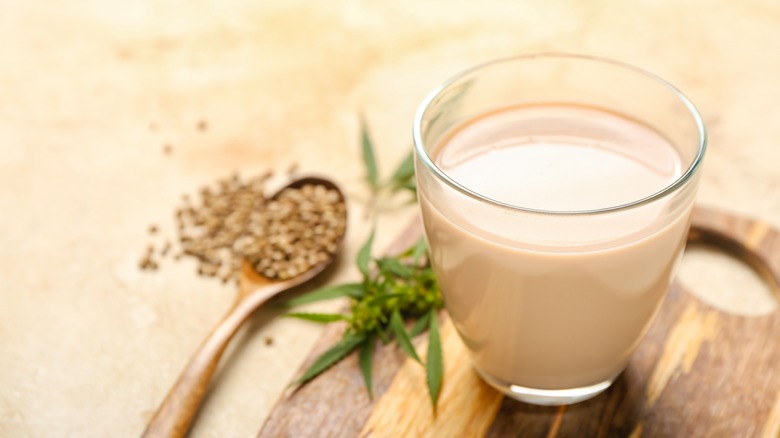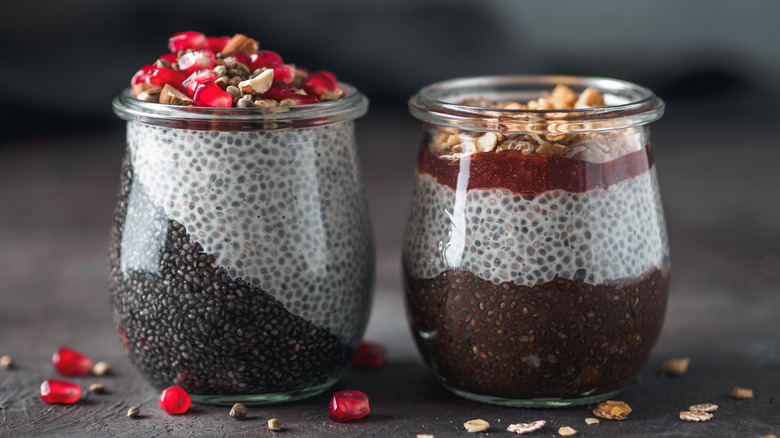What Is Hemp Milk And What Does It Taste Like?
There is an abundance of non-dairy milk choices on offer these days. A visit to the local coffee shop or grocery store is often an exercise in avoiding milk-alternative-choice fatigue — there are just so many types of plant milk! Though less popular than other milk alternatives like almond, soy, and oat, hemp milk is gaining traction in the growing plant-based milk market, which generated $2.6 billion in U.S. retail sales in 2021, according to the Plant Based Foods Association. That is a lot of soy, nuts, and oats.
Though it won't get you high, hemp milk might just be coming to replace the nation's beloved almond milk. It's certainly more sustainable, which might be one of the reasons that projections for the global hemp milk market are on the rise. But what does it taste like? In short, it's not like cannabis or hops (which both belong to the same plant family as hemp), so hemp milk is much more palatable than you might think. Read on to learn more about hemp milk's benefits, origins, and cooking possibilities, and why you should consider reaching for it next time you're in the milk aisle.
Hemp plants have been cultivated for thousands of years
Though your local barista might look at you strangely when you ask for it, hemp milk and other hemp-based products are not new. Far from it, the plant has been cultivated for thousands of years for varied uses, and particularly valued for the strength and adaptability of its fiber. Hemp's cultivation can be traced back to at least 2800 B.C. in China, and it has since spread throughout Europe, South America, and beyond.
Though hemp is part of the Cannabaceae family, it cannot alter your state of mind due to its extremely low dose of tetrahydrocannabinol (THC), the psychoactive compound in related cannabis plants.
Hemp is primarily grown in temperate climates and harvested annually. It grows best in sandy soil with good drainage. Depending on the farmer's intentions for the crop, plants are either grown closer together if used for fiber or textile purposes, or further apart if the crop is grown for its oil-packed seeds. Hemp is ready to be cut for fiber production once it blooms.
Hemp milk is a plant-based milk alternative made from hemp seeds
Unlike twine and textiles made from the stalks of the hemp plant, hemp milk is made from hemp seeds, known for their nutritional density. Once again, hemp milk will not affect your mental clarity, as there is far too little of the THC known to soften edges and whet appetites.
For those wishing to make hemp milk at home, this dairy alternative can have as little as two ingredients — water and hulled hemp seeds. You can also add sweeteners such as vanilla extract, maple syrup, or dates to maximize enjoyment and mimic some of the sweetness of dairy milk. Commercially manufactured hemp milk, as with other non-dairy alternatives, will often contain additional ingredients, including stabilizers, thickening agents, salt, or sweeteners.
Hemp milk is also known for its creaminess and rich, thick texture, making it a fantastic alternative to dairy milk for splashing into coffee or pouring over cereal. It is naturally free of nut, soy, gluten, and lactose content, making it a good option for those who need to be mindful about certain ingredients.
Hemp seeds are a highly nutritious foodstuff
Move over, quinoa; hemp seeds are the real superfood. They can be used in sweet or savory foods — from muffins to oatmeal, salad dressings to rice — to boost nutrition and add depth with their sweet, nutty flavor. The seeds can also be used to make dairy-free cheeses and plant-based protein powders. And these are just a few reasons why you should add more hemp seeds to your diet.
One of the main benefits of using hemp milk, made from hemp seeds, is its nutritional value. Hemp seeds are a fantastic plant-based source of omega-3 and omega-6 fatty acids, which are known to boost cardiovascular health. These seeds also contain potassium, calcium, zinc, and iron, along with vitamins A, D, and E.
Hemp seeds are a source of phytosterols, which can help reduce cholesterol levels, and magnesium, which helps with metabolism, muscle function, and the prevention of osteoporosis. Containing all nine essential amino acids, hemp seeds also provide a fantastic source of plant-based protein.
Precautionary reasons why consumers may opt against hemp milk would be its potential interactions with blood-thinning medications and possible allergy concerns. A study published by the National Library of Medicine indicates that people who are allergic to hazelnuts may experience cross-reactivity with hemp seed allergens, but more research on this is required.
Hemp can also be used in many ways, including oils, cheeses, and fibers
Hemp has a wide range of usages, from clothing to paper, insulation to oils, making it a versatile cultivated crop. Its fiber can be made into strong and sturdy rope, twine, or string. Equally, it is woven to create textiles ranging from canvas to linen, and used for clothing, bags, or even shoes. Hemp is also used to make paper, as well as sustainable building materials. Hemp is durable, strong, and supple, making it a fantastic product for multiple uses.
Hemp seeds are cultivated and used to produce various edible and non-edible products. The seeds are known for their rich oils, used in making anything from paint and soaps to plant-based cheese, along with fantastic oils for salads, hummus, or dips. Hemp oil can be drizzled on finished dishes, or used for light frying with short cook times. However, hemp oil has a low smoke point and should not be used for deep frying, high-heat grilling, or other cooking that involves high, direct heat.
Hemp seeds can be eaten raw, used in baking, blended into smoothies, or scattered into rice dishes and salads. They are also used to make hemp milk.
Hemp milk has its own unique flavor and texture
All this talk of how brilliant hemp cultivation is begs the question, "What does hemp milk actually taste like?" The flavor of hemp milk is likened to the taste of sunflower seeds, meaning it has a nutty, earthy flavor with a gentle sweetness. The same could be said about many plant-based milks, though hemp milk does have a distinctive taste that's all its own. It is slightly grassier and earthier than other dairy-free alternatives like almond milk, which is why it may benefit from adding sweet ingredients like vanilla or dates to help balance the flavors.
Texture-wise, hemp milk is creamy, rich, and thick due to the oil composition of its seeds totaling around 30%. Though not quite as creamy as whole dairy milk, its texture is slightly thicker than 2% dairy milk, making it a satisfying addition to milk-dominant foods like smoothies and a welcome plant-based substitution in creamy soups, desserts like pudding, or baking.
You can purchase hemp milk in grocery stores or make your own
Like all other plant-based milks, consumers can purchase hemp milk from the grocery store or experiment with making it at home. It all boils down to preference in taste, access to resources, and time.
A growing number of hemp-based milk products are sold by several brands, with varieties including sweetened and unsweetened, or flavored with chocolate, vanilla, and coconut.
For those who wish to try their hand at making hemp milk at home, the ingredient list is relatively low, largely consisting of hemp seeds and water. You can, however, add other optional flavorings, including a pinch of sea salt, dates, vanilla extract, cocoa powder, or fresh berries.
During storage, hemp seeds should be kept in a sealed, airtight container and placed in a cool, dry area to prevent moisture from spoiling the seeds. To make the milk, combine the seeds, water, and additional flavorings in a high-speed blender. For a smoother texture, you can strain the mixture using a cheesecloth or thin towel, as you would with other nut-based milk. Homemade hemp milk should last in the fridge for up to five days.
Hemp milk is more sustainable than other plant-based milks
Though almond milk is predominant in the U.S. plant-based milk industry, it is notorious for the massive amount of water needed to sustain almond orchards, as well as the negative effects of almond agriculture on honeybees that pollenate this crop. The high water usage is especially damaging, as most of the world's supply of almonds is grown in California, where droughts and wildfires are already commonplace. These factors contribute to almond milk's unenviable status on the list of which plant-based milk is the most sustainable.
Soy-based milk is not without its issues, as the rising global demand for soy products has been linked to wide-scale devastation of rainforests and other natural habitats to clear land for soy cultivation. Although the production of any plant-based milk results in considerably less greenhouse gas emissions than the output of dairy farms, it's helpful to know the costs as well as the benefits to milk alternatives.
Hemp production is considered to be eminently sustainable, partially because fast-growing hemp can be grown on land that is unsuitable for other crops, and hemp plants are very effective in carbon storage. It's also a relatively sturdy crop that generally doesn't require pesticides, and hemp may improve soil for other crops when planted in rotation.
The cost of hemp milk tends to be higher than other plant-based milks
Hemp milk typically comes at a higher cost to the consumer than purchasing other plant-based milk alternatives. For those who plan to use a larger volume of the product each week, it might be worth running the costs of buying hemp seeds in bulk and regularly whipping up your own batches of hemp milk — just be sure to avoid the biggest mistakes with making homemade plant milk while preparing it.
Store-bought hemp milk can cost about $2 to $4 more per quart than almond milk. Though this extra cost may be negligible when only purchasing one quart at a time, it can add up quickly. However, you could raise the point that quart-per-quart, you also get what you pay for, as hemp milk is more nutritionally dense and a better source of plant-based protein than almond milk.
Hemp milk's popularity is projected to increase
According to the summary of a report published by Future Market Insights, hemp milk might just be the next big thing for the world of plant-based milk alternatives. The global hemp milk market is projected to reach a value of $236.4 million by 2032, so it will likely start popping up more widely alongside soy, almond, and oat-based dairy products. Due to hemp's nutrient-dense makeup, it's a match made in heaven for the ever-growing wellness market and the expanding vegan-based product sections of supermarket shelves and fridges. We would not be surprised to see dedicated cases for products like hemp-based yogurts, cheeses, and ice creams in the not-so-distant future.
The same report also predicts that consumption of hemp milk will not only take off in American markets, but will grow even faster in European markets, projecting that Italy will have the highest demand. Only time will tell how these projected figures could affect how widely hemp is cultivated.
There are many ways to use hemp milk at home
As the saying goes, how long is a piece of string? The list of ways in which you can use hemp milk at home can be as short or as long as you wish it to be. Given its thick, creamy texture, hemp milk is fantastic in smoothies. You can use it to make rich oatmeal and fluffy vegan pancakes, or pour it over your breakfast cereal of choice. You can also use hemp milk to make delicious vegan ice cream, or blend it into satisfying and warming plant-based soups like tomato or butternut. Hemp milk can also be substituted for just about any other dairy or non-dairy alternative in baking.
If you're looking for ways to incorporate hemp milk into your usual routine, start small and build from there. Change up your overnight oats breakfast routine with hemp milk; its thick, creamy texture and earthy flavor match perfectly with oats, and balances out well with sweet fruits. Or add hemp milk alongside a banana, some berries, honey or maple syrup, a sprinkle of chia seeds, and a dash of cinnamon to create a tasty breakfast smoothie. The key is to play around, using your taste buds and sense of adventure as your guide.
